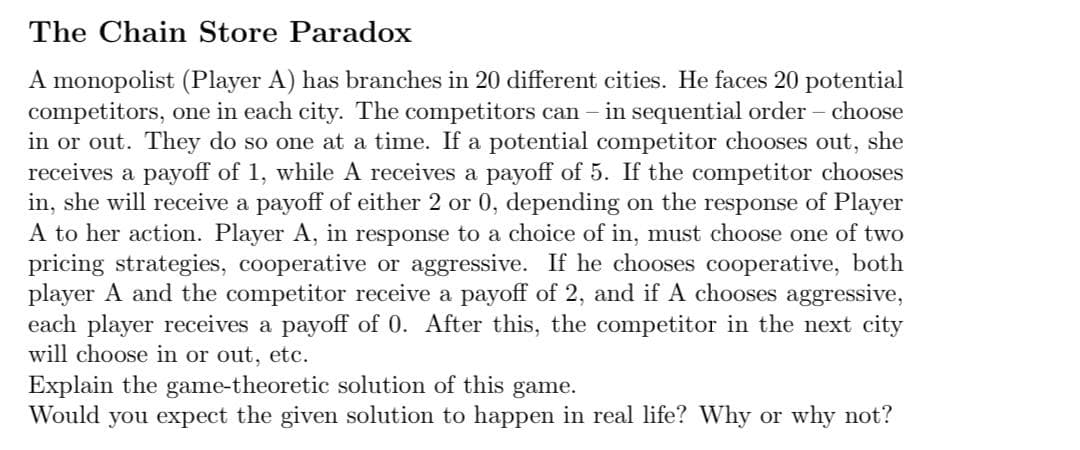The Chain Store Paradox A monopolist (Player A) has branches in 20 different cities. He faces 20 potential competitors, one in each city. The competitors can – in sequential order – choose in or out. They do so one at a time. If a potential competitor chooses out, she receives a payoff of 1, while A receives a payoff of 5. If the competitor chooses in, she will receive a payoff of either 2 or 0, depending on the response of Player A to her action. Player A, in response to a choice of in, must choose one of two pricing strategies, cooperative or aggressive. If he chooses cooperative, both player A and the competitor receive a payoff of 2, and if A chooses aggressive, each player receives a payoff of 0. After this, the competitor in the next city will choose in or out, etc. Explain the game-theoretic solution of this game. Would you expect the given solution to happen in real life? Why or why not?
The Chain Store Paradox A monopolist (Player A) has branches in 20 different cities. He faces 20 potential competitors, one in each city. The competitors can – in sequential order – choose in or out. They do so one at a time. If a potential competitor chooses out, she receives a payoff of 1, while A receives a payoff of 5. If the competitor chooses in, she will receive a payoff of either 2 or 0, depending on the response of Player A to her action. Player A, in response to a choice of in, must choose one of two pricing strategies, cooperative or aggressive. If he chooses cooperative, both player A and the competitor receive a payoff of 2, and if A chooses aggressive, each player receives a payoff of 0. After this, the competitor in the next city will choose in or out, etc. Explain the game-theoretic solution of this game. Would you expect the given solution to happen in real life? Why or why not?
Chapter8: Game Theory
Section: Chapter Questions
Problem 8.7P
Related questions
Question
H8

Transcribed Image Text:The Chain Store Paradox
A monopolist (Player A) has branches in 20 different cities. He faces 20 potential
competitors, one in each city. The competitors can
in or out. They do so one at a time. If a potential competitor chooses out, she
receives a payoff of 1, while A receives a payoff of 5. If the competitor chooses
in, she will receive a payoff of either 2 or 0, depending on the response of Player
A to her action. Player A, in response to a choice of in, must choose one of two
pricing strategies, cooperative or aggressive. If he chooses cooperative, both
player A and the competitor receive a payoff of 2, and if A chooses aggressive,
each player receives a payoff of 0. After this, the competitor in the next city
will choose in or out, etc.
in sequential order – choose
Explain the game-theoretic solution of this game.
Would you expect the given solution to happen in real life? Why or why not?
Expert Solution
This question has been solved!
Explore an expertly crafted, step-by-step solution for a thorough understanding of key concepts.
This is a popular solution!
Trending now
This is a popular solution!
Step by step
Solved in 4 steps

Knowledge Booster
Learn more about
Need a deep-dive on the concept behind this application? Look no further. Learn more about this topic, economics and related others by exploring similar questions and additional content below.Recommended textbooks for you


Managerial Economics: A Problem Solving Approach
Economics
ISBN:
9781337106665
Author:
Luke M. Froeb, Brian T. McCann, Michael R. Ward, Mike Shor
Publisher:
Cengage Learning


Managerial Economics: A Problem Solving Approach
Economics
ISBN:
9781337106665
Author:
Luke M. Froeb, Brian T. McCann, Michael R. Ward, Mike Shor
Publisher:
Cengage Learning